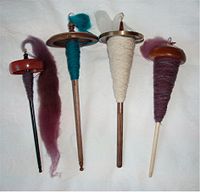A spindle is a straight spike usually made from wood used for spinning, twisting fibers such as wool, flax, hemp, cotton into yarn. It is often weighted at either the bottom, middle, or top, commonly by a disc or spherical object called a whorl, but many spindles exist that are not weighted by a whorl, but by thickening their shape towards the bottom, such as Orenburg and French spindles. The spindle may also have a hook, groove, or notch at the top to guide the yarn. Spindles come in many different sizes and weights depending on the thickness of the yarn one desires to spin. The origin of the first wooden spindle is lost to history because the materials didn't survive. Whorl-weighted spindles date back at least to neolithic times; spindle whorls have been found in archaeological digs around the world. A spindle is also part of traditional spinning wheels, such as the Indian charkha and the great or walking wheel. In industrial yarn production, spindles are used as well; see spinning jenny, spinning mule and ring spinning. Modern hand spindles fall into two basic categories: drop spindles, and supported spindles. Drop spindles are so named because they are dropped to swing from the yarn after rotation has been started on one's thigh or any other convenient body part, allowing for a greater length of yarn to be spun before winding on. They also permit the spinner to move around while spinning, going about their day. However, there are practical limits to their size/weight. Drop spindles are commonly available in high-whorl, low-whorl, and centre-whorl versions. In a high-whorl spindle, the whorl sits very close to the top of the shaft which allows the spindle to spin very fast. A hook is placed on the top of the shaft to secure the developing yarn, and the newly spun yarn is wound around the shaft underneath the whorl in a conical shape called a cop. In a low-whorl spindle, the whorl sits near the bottom of the shaft, which makes it spin slower, but more steadily, and longer. The newly spun yarn is wound around the shaft just above the whorl. In centre-whorl spindles the cop is usually built above the whorl. Most supported spindles continue to rest with the tip on one's thigh, on the ground, on a table, or in a small bowl while rotating. French spindles are "twiddled" between the fingers of one hand instead. The Akha spindle, a short spindle with a large centre-whorl disc, is supported by the hand of the spinner during drafting of cotton fibre, but during the adding of extra twist to stabilize the yarn, the spindle is dropped to rest on the yarn. Supported spindles come in a great variety of sizes, such as the very large, ~30" Navajo spindle, the small, extremely fast, metal tahkli for spinning cotton, and the tiniest Orenburg spindles (~20cm, 15gm) for spinning gossamer lace yarns. A familiar sight from history books is a spindle used in conjunction with a distaff, an upright stick with a large quantity of loose fibre wound around it, to be easily accessed. There are many other methods for controlling the pre-spun fibre, such as coiling it around one's lower arm, or through a bracelet, or wrapping it loosely around a yarn braid hanging from one's wrist. Spindles can also be used for plying: intertwining 2 or more single strands of yarn together in order to create a stronger, more balanced, more durable yarn.




Comment
0